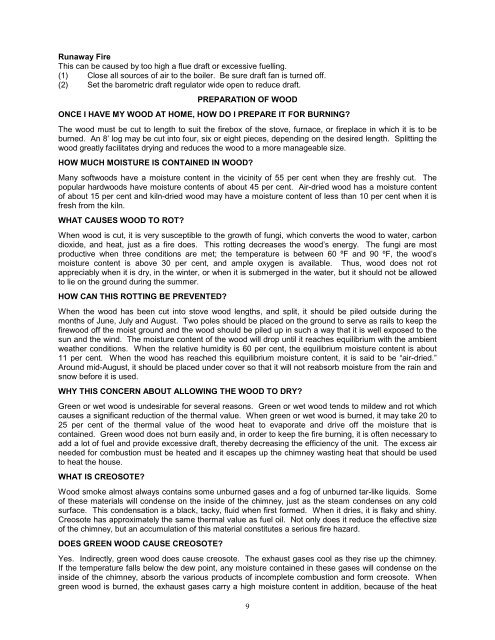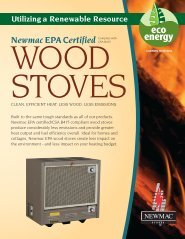INSTALLATION, OPERATING and SERVICE MANUAL - Newmac ...
INSTALLATION, OPERATING and SERVICE MANUAL - Newmac ...
INSTALLATION, OPERATING and SERVICE MANUAL - Newmac ...
Create successful ePaper yourself
Turn your PDF publications into a flip-book with our unique Google optimized e-Paper software.
Runaway Fire<br />
This can be caused by too high a flue draft or excessive fuelling.<br />
(1) Close all sources of air to the boiler. Be sure draft fan is turned off.<br />
(2) Set the barometric draft regulator wide open to reduce draft.<br />
PREPARATION OF WOOD<br />
ONCE I HAVE MY WOOD AT HOME, HOW DO I PREPARE IT FOR BURNING?<br />
The wood must be cut to length to suit the firebox of the stove, furnace, or fireplace in which it is to be<br />
burned. An 8’ log may be cut into four, six or eight pieces, depending on the desired length. Splitting the<br />
wood greatly facilitates drying <strong>and</strong> reduces the wood to a more manageable size.<br />
HOW MUCH MOISTURE IS CONTAINED IN WOOD?<br />
Many softwoods have a moisture content in the vicinity of 55 per cent when they are freshly cut. The<br />
popular hardwoods have moisture contents of about 45 per cent. Air-dried wood has a moisture content<br />
of about 15 per cent <strong>and</strong> kiln-dried wood may have a moisture content of less than 10 per cent when it is<br />
fresh from the kiln.<br />
WHAT CAUSES WOOD TO ROT?<br />
When wood is cut, it is very susceptible to the growth of fungi, which converts the wood to water, carbon<br />
dioxide, <strong>and</strong> heat, just as a fire does. This rotting decreases the wood’s energy. The fungi are most<br />
productive when three conditions are met; the temperature is between 60 ºF <strong>and</strong> 90 ºF, the wood’s<br />
moisture content is above 30 per cent, <strong>and</strong> ample oxygen is available. Thus, wood does not rot<br />
appreciably when it is dry, in the winter, or when it is submerged in the water, but it should not be allowed<br />
to lie on the ground during the summer.<br />
HOW CAN THIS ROTTING BE PREVENTED?<br />
When the wood has been cut into stove wood lengths, <strong>and</strong> split, it should be piled outside during the<br />
months of June, July <strong>and</strong> August. Two poles should be placed on the ground to serve as rails to keep the<br />
firewood off the moist ground <strong>and</strong> the wood should be piled up in such a way that it is well exposed to the<br />
sun <strong>and</strong> the wind. The moisture content of the wood will drop until it reaches equilibrium with the ambient<br />
weather conditions. When the relative humidity is 60 per cent, the equilibrium moisture content is about<br />
11 per cent. When the wood has reached this equilibrium moisture content, it is said to be “air-dried.”<br />
Around mid-August, it should be placed under cover so that it will not reabsorb moisture from the rain <strong>and</strong><br />
snow before it is used.<br />
WHY THIS CONCERN ABOUT ALLOWING THE WOOD TO DRY?<br />
Green or wet wood is undesirable for several reasons. Green or wet wood tends to mildew <strong>and</strong> rot which<br />
causes a significant reduction of the thermal value. When green or wet wood is burned, it may take 20 to<br />
25 per cent of the thermal value of the wood heat to evaporate <strong>and</strong> drive off the moisture that is<br />
contained. Green wood does not burn easily <strong>and</strong>, in order to keep the fire burning, it is often necessary to<br />
add a lot of fuel <strong>and</strong> provide excessive draft, thereby decreasing the efficiency of the unit. The excess air<br />
needed for combustion must be heated <strong>and</strong> it escapes up the chimney wasting heat that should be used<br />
to heat the house.<br />
WHAT IS CREOSOTE?<br />
Wood smoke almost always contains some unburned gases <strong>and</strong> a fog of unburned tar-like liquids. Some<br />
of these materials will condense on the inside of the chimney, just as the steam condenses on any cold<br />
surface. This condensation is a black, tacky, fluid when first formed. When it dries, it is flaky <strong>and</strong> shiny.<br />
Creosote has approximately the same thermal value as fuel oil. Not only does it reduce the effective size<br />
of the chimney, but an accumulation of this material constitutes a serious fire hazard.<br />
DOES GREEN WOOD CAUSE CREOSOTE?<br />
Yes. Indirectly, green wood does cause creosote. The exhaust gases cool as they rise up the chimney.<br />
If the temperature falls below the dew point, any moisture contained in these gases will condense on the<br />
inside of the chimney, absorb the various products of incomplete combustion <strong>and</strong> form creosote. When<br />
green wood is burned, the exhaust gases carry a high moisture content in addition, because of the heat<br />
9




